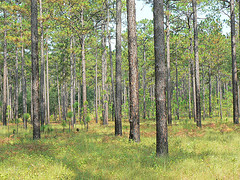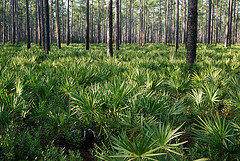Longleaf, Hope for Landowners Who Grow Pine in the South
By: Amos S. Eno
Posted on:03/08/2011 Updated:03/15/2011Restoration of longleaf pine ecosystems is the “secret ingredient” for success in managing wildlife, wildfire, habitat, and plants in the Deep South
This is the first in a series of three blog posts about longleaf pine in the South. We’ll try to answer why longleaf? We’ll talk to landowners who are restoring longleaf on their property, and we’ll learn about the resources available to landowners who wish to make the switch.
Southern pines as they greeted the first European explorers were described as “the most stately pine trees that can be imagined, planted by nature at a moderate distance. . . enameled with a variety of flowering shrubs.” Yet today there are problems in America’s Southern pine forests that can feel overwhelming.
Here’s a brief list of the maladies that afflict Southern pines:
- encroaching exotic species like privet and cogongrass;
- increasing susceptibility to wildfire, caused by drought and more importantly, fuel buildups;
- a growing list of declining or listed threatened and endangered species, including the Red-cockaded Woodpecker and Gopher Tortoise;
- the spread of Southern Pine beetle, which causes roughly $800,000 in damage annually in Alabama alone;
- increasing loss of forest cover and timber value to wind damage from storms and hurricanes, such as Ivan, Katrina and Rita, that swoop in from the Gulf or the Atlantic;
- the squeeze on landowners to grow timber sustainably and still make a profit;
- the desire for recreational value that declines as all of the above-listed problems increase.
What’s a landowner to do? What kind of impact can a single landowner make on his or her land? A lot, as it turns out.
A Simple Guiding PrincipleAll of these problems can be turned around simply by restoring longleaf pine ecosystems. The restoration, of course, is not that simple - but the guiding principle is.
Problems that we face in the South today in large part find their origins in the wholesale conversion of native longleaf pine forests to loblolly and other species of pine. The conversion happened in the late 1800s and early 1900s as lo

ngleaf was intensively logged for its fine straight poles and the production of tar and turpentine. After all the longleaf was gone, everyone wanted loblolly, since it appeared to be the more profitable and faster-growing species.
However, studies conducted by researchers and organizations affiliated with the
Longleaf Alliance over the past decade have revealed a truth about longleaf that had been forgotten: over a 25- to 30-year rotation, its growth catches up to loblolly. What’s more, it grows straighter and fetches a premium price for poles compared to the price of pulpwood.
Check, on the need for sustainable and profitable timber!
Glen Gaines, Regional Longleaf Restoration Coordinator for the Forest Service, says, “Ecologically, longleaf forest is a fire adapted system that supports groups of species now fairly rare or declining because of their dependence on these kinds of habitats. The list includes Northern Bobwhite Quail, Wild Turkey, the federally-listed endangered Red-cockaded Woodpecker, and species that need the grassy understory associated with periodic fire: Gopher Tortoise, Black Indigo Snakes, and Eastern Diamondback Rattlesnakes. Also, some of the richest plant communities in North America occur here, with upwards of 100 or more plant species in a square meter, many of which are fire dependent.”
Check, endangered species and plants.
Check, susceptibility to wildfire, which decreases

with regular burning.
And check, many (though not all) species of invasive plants, which often are not fire-adapted.
Just as importantly, a longleaf forest is quite beautiful. As
one award-winning landowner in Alabama puts it, “My feelings about longleaf and fire are that you can enjoy it along the way, as you’re managing it, because the whole ecosystem supports more native grasses, forbs and wildlife like deer, turkey, and quail.”
Check, increasing recreational value.
In fact, the more I talk to people involved in longleaf restoration, the more I have begun to think of them as having “got religion” - the kind with tufts of three needles 8 to 18 inches long.
How about disease and storm damage? “Longleaf, also known as pitch pine, responds with a greater flow of sap when attacked, making it less susceptible to the Southern Pine Beetle,” explains Gaines.
Check, insect pests.
Studies conducted subsequent to the rash of hurricanes we’ve endured over the past 10 to 15 years have compared longleaf to slash and loblolly pine. Gaines says, “Longleaf typically comes through those storms much better than loblolly or slash. Though longleaf may be damaged, the trees retain higher salvage value because they are typically root sprung or bent, rather than broken.”
Check, storm and wind damage.
In short, there are many reasons that longleaf is growing in popularity among landowners and conservationists throughout the South. Next week I’ll introduce you to a landowner who “got religion” after Hurricane Ivan and has become expert in restoring and maintaining his longleaf woodlands.
Feedback
re: Longleaf, Hope for Landowners Who Grow Pine in the SouthBy: Joyce Hart on: 03/12/2011Thank you for spreading the word about longleaf regeneration. With each longleaf stand comes a personal story that often stretches across generations. My husband's family homesteaded in Covington County, a stone's throw away from the Longleaf Alliance. We are very grateful for the work of the Alliance and landowners like Dr. Saloom whom, I believe, you will be featuring next week.
 Sign In
Sign In
 Sign In
Sign In
